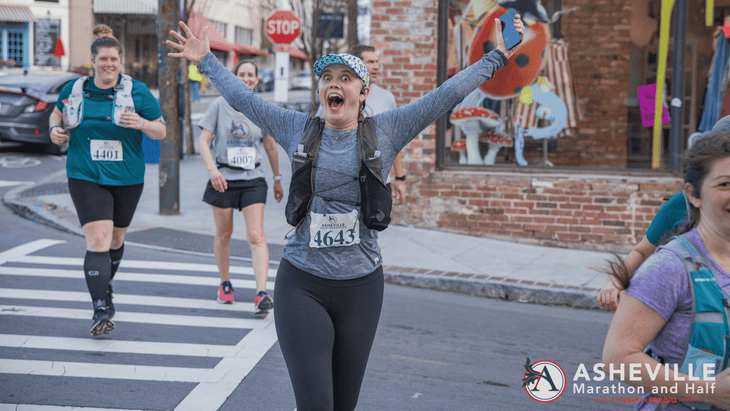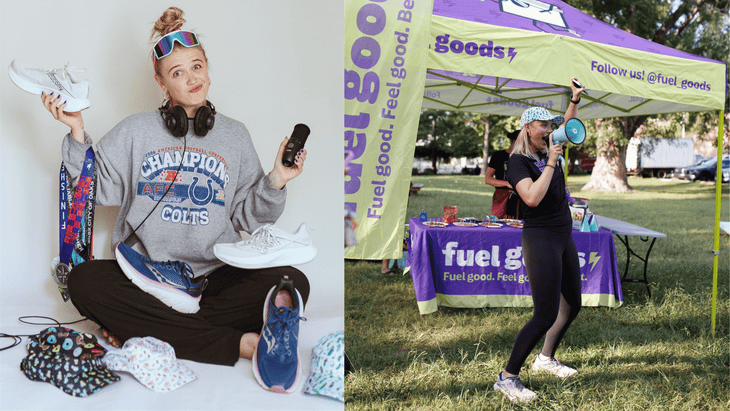New perk: Easily find new routes and hidden gems, upcoming running events, and more near you. Your weekly Local Running Newsletter has everything you need to lace up! Subscribe today.
When Makenzie Rink crossed the finish line of her first half marathon, she had just one thought: I am never doing that again.
She had picked up running at age 21 as a way to control her anxiety, find some fresh air during the Covid-19 pandemic, and burn off the energy of her Border Collie puppy, Finley. Running checked all of those boxes—at a cruel price.
Her legs went numb during her first three-mile run. Even as her body adjusted to the training, Rink never really adjusted to enjoying it. And her reward for surviving the half marathon? Rink’s IT band complained like a hungry toddler for the next six months.
This doesn’t exactly sound like the path of a running influencer. And yet, you may know of Rink, 24, as @the.realistic.runner on TikTok, where she has nearly 25,000 followers. Rink actually hates social media—she’s quit her accounts a half-dozen times. Fans of the hit TV show Severance could say it’s almost as if The Realistic Runner is the innie, the worker bee who has her own life and wants to rebel against her outie, Makenzie Rink.
That’s almost true, but not quite— because Rink loves running now. She loves it so much that she traveled to “too many” races last year, she said. She swore she would take a break from pinning on a bib, only to sign up for another half marathon and enter the New York City Marathon lottery.
“WTF?” You may be asking. Sometimes she still asks herself that, too. But the story behind her own running journey is exactly why she became The Realistic Runner. And once you hear it, you may find her more than realistic.

Slow and Steady Finishes the Race
Rink was not a sack of Jello before she started running. She was a somewhat competitive swimmer in high school and she adapted to running quickly. Before long she was running 9-minute miles. Except, the thing was, she was miserable. She hated running that fast.
“I thought that’s what you had to do to be a runner,” Rink said.
She gave up running. But a few months later on May, 2022, running sucked her back in when her beloved aunt Em got sick. It didn’t seem possible. Her aunt worked out voraciously, ate well, and was so in tune with her body she was like a watch craftsman. Her husband did Ironman triathlons. Yet the illness was so sudden and so severe that she was hospitalized for two years.
“She didn’t have the ability to go out and just breathe fresh air,” Rink said. “It puts life in perspective. It makes you realize how lucky you are.”
Rink wanted to honor her aunt and revel in her own newfound fortune. She decided to run the Chicago Marathon with her mother and raise money for cystic fibrosis, the closest disease she could find to her aunt’s lung ailments. And yet, running still, quite frankly, sucked. She was so burned out at the end of an 18-miler that she asked her uncle for advice. He asked Rink if she’d ever heard of heart-rate zone training.
That changed everything.
It wasn’t the heart-rate training itself that revolutionized her running so much as the excuse it gave her to slow down. Heart-rate training, among other things, encourages a lot of running at a conversational, easy pace, or zone 2 in a five-zone model. Going slow, she said, made running enjoyable. She even—gasp—took walk breaks! She found this new style of running so fun that she ditched her sub-4-hour time goal for Chicago.
“I wanted to enjoy the experience,” Rink said. “It became the one thing in life I do that isn’t a million miles an hour.”
When a friend suggested that she start a TikTok about training “slowly” for the marathon, she rejected the idea. Rink worked in social media at a consulting firm, which is probably why, looking back, she hated it: Imagine a bus driver doing a few laps for fun in a parking lot after she clocks out. But when Rink posted her runs at 12-to-15-minute-per-mile pace on Strava, she began to ask a question in the comments: Where are my realistic runners at?
“I wanted to show that a 9-minute pace is not a pace that’s easy for a lot of people,” Rink said. “It is not reality. A 12-minute or 15-minute mile is my reality.”
Being the turtle, instead of the hare, not only gave her joy. It gave her a voice.

No Runner Left Behind
“All paces are welcome. Bullshit.”
Rink stared into the camera with a fire in her eyes as she uttered these words. She had moved back to Asheville, North Carolina, to live with her parents after graduating from North Carolina State University in 2023. And it was there at a local running store that she had just attended her first group run. She had to share the experience with the world.
“I got left behind,” Rink says.
Rink had wanted some accountability with her running, so she showed up for the group run, thinking it was OK that she was a little slower. The group quickly abandoned her in a flurry of turns, side streets, and traffic lights. The slowest runner ran 10-minute miles.
“That wasn’t where I was at,” she said. “But I had run a marathon. I was a runner. I didn’t need to prove that to anyone. It made me feel less than. It sucked.”
Rink’s anger about the unspoken, harsh reality of group runs, even when they’re advertised for “all paces,” struck a nerve with many other slower runners. They, too, felt left behind—even if they’d never show up to a group run for this very reason. There were countless examples, from a local 5K where the race director began cleaning up before everyone had finished, to marathons that sweep runners off the course after six hours.
Rink’s TikTok about that group run experience got nearly 70,000 views and 4,500 likes. Her following took off.
@the.realistic.runner All paces are welcome. Such a simple phrase and one that so many people use when organizing group runs and yet… Its not supported. And leaves many runners feeling like they don’t belong. So know, that if you have never felt welcome at a group run… you aren’t alone. You belong in this space and you are a runner no matter what 🤍 #runtok #runner #slowrunner #relatable #fyp #foryourpage #viral ♬ Live in the Spirit – Josué Novais Piano Worship & Instrumental Worship and Prayer
Slower runners began to contact her about forming a slow pace group. That’s since grown to Rink hosting slower shake-outs before her races where dozens of runners will show up. The social aspect of being an influencer wasn’t something she’d considered: Her introverted nature was another reason she quit social media several times, and now other runners were recognizing her on Asheville’s popular running paths.
“I was just finding my people,” Rink said. “I realized I wasn’t alone in this, and that, yeah, I did want a community. Running is a sport where you can take back a lot of control or doubt you were having and reclaim that self confidence. I wanted people to see that.”
She had to learn how to create a “family-type environment,” she said, and take care that the routes didn’t have a lot of turns that slower runners could miss. The biggest challenge, though, was in communicating that all paces were welcome—and she actually meant it.
“You have to acknowledge that it’s an awkward experience,” she said. “You’re sweating and breathing hard. It’s not cute. But you want a place where they can be their most authentic self.”
Rink recently took a job as a store manager and event coordinator in Kentucky. She doesn’t like brand deals.
“I knew I didn’t want to be a creator who just said ‘yes’ to all that,” she said. “I want to make running accessible to people.”
She has doubts, she admitted, about her own social media account and whether she’s doing the right thing. She is still a “slow” runner, but she is not weak. She ran several marathons last year, some within weeks of each other. She knows that isn’t for everyone and could even get some other runners hurt.
“We are wired to seek that validation,” Rink said. “But authentically, I am myself, or I try to be.”
Rink continues to honor her aunt, who died last year. It’s possible that her aunt knew all along that Rink had The Realistic Runner inside her.
“She was always my biggest encourager,” Rink said. “She saw something in me I could never see in myself.”
